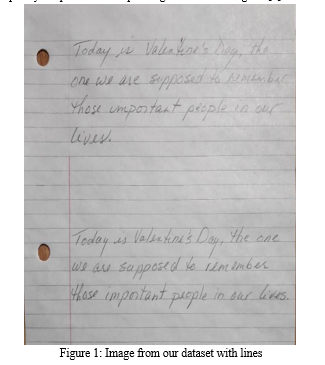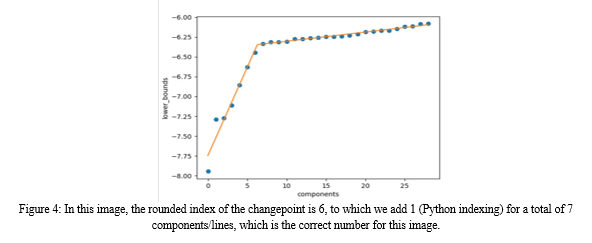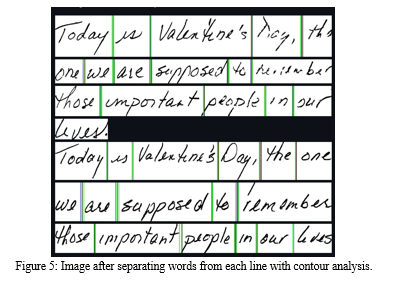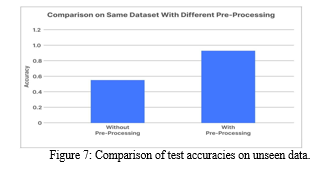Ijraset Journal For Research in Applied Science and Engineering Technology
- Home / Ijraset
- On This Page
- Abstract
- Introduction
- References
- Copyright
Preprocessing Low Quality Handwritten Documents for OCR Models
Authors: Kunal Jaiswal, Avichal Suneja, Aman Kumar, Anany Ladha, Nidhi Mishra
DOI Link: https://doi.org/10.22214/ijraset.2023.50664
Certificate: View Certificate
Abstract
Handwriting recognition using OCR (Optical Character Recognition) is a transformative technology that is rapidly changing the way we interact with handwritten documents. OCR technology has traditionally been used for scanning printed text, but with advancements in machine learning and computer vision, it is now possible to recognize and digitize handwritten text as well. This has immense practical implications, as it enables handwritten notes, letters, and documents to be easily searchable, editable, and shareable in digital formats[1]. However, despite its potential, handwriting recognition using OCR is still a relatively nascent technology and faces several challenges. One of the main challenges is the recognition of handwriting styles that vary widely across individuals and cultures. Another challenge is interpreting handwriting that is difficult to read, such as cursive writing or handwritten notes with smudges or crossed out words. Additionally, OCR software is highly dependent on the quality of the input image, making it important to optimize the lighting and capture settings for accurate results.[2] As OCR technology continues to improve, it has the potential to revolutionize the way we interact with handwritten documents and usher in a new era of digital transformation.
Introduction
I. INTRODUCTION
Preprocessing of low-quality handwritten documents is a crucial step in OCR models, but it can also be a significant challenge. The preprocessing step involves applying various image enhancement techniques to improve the quality of the input image and to make it easier for the OCR algorithm to recognize the characters accurately. However, low-quality handwritten documents pose unique problems that need to be addressed carefully during the preprocessing stage[3]. One of the main problems with low-quality handwritten documents is the presence of noise and distortions. Noise can be caused by various factors such as poor lighting, smudges, or ink bleeding, which can make it difficult for the OCR algorithm to distinguish between characters. Distortions can be caused by factors such as skew or slant, which can also affect the accuracy of OCR results. Another problem with low-quality handwritten documents is the presence of irregularities in the handwriting itself. This can include unusual shapes, line thicknesses, or spacing between characters, which can further complicate the OCR recognition process. Furthermore, handwritten text can often overlap, making it difficult to separate individual characters or words.[4] Preprocessing techniques for low-quality handwritten documents typically involve a combination of image enhancement and segmentation techniques. Image enhancement techniques may include noise reduction, contrast enhancement, and normalization of the image. Segmentation techniques involve separating the individual characters or words in the image to make it easier for the OCR algorithm to recognize them accurately. However, even with these preprocessing techniques, recognition accuracy may still be limited for low-quality handwritten documents. To overcome these challenges, researchers are exploring advanced techniques such as deep learning-based models that can learn to recognize and correct distortions and irregularities in handwriting. In conclusion, preprocessing of low-quality handwritten documents is an important step in OCR models, but it requires careful attention to the unique challenges presented by low-quality handwriting. Future research is needed to continue to improve OCR technology and to enable accurate recognition of even the most challenging handwritten documents.
II. MARKOV RANDOM FIELD
We decided to use Markov Random Field as a part of our pre-processing algorithm. One of the main advantages of MRFs is their ability to model spatial dependencies between adjacent pixels in an image. This is particularly relevant in the case of handwritten documents, where characters can be overlapped or have irregular shapes. By modeling the spatial dependencies between adjacent pixels, MRFs can help to separate individual characters or words, making it easier for the OCR algorithm to recognize them accurately.
MRFs can also be used to model the prior probability of each pixel in an image belonging to a certain character class. This information can be used to improve the accuracy of the segmentation process and to reduce errors in OCR recognition. Furthermore, MRFs can be trained using a maximum likelihood or Bayesian approach to optimize the model parameters for a specific dataset. This can help to improve the accuracy of the segmentation and recognition process, particularly for low-quality or noisy handwritten documents.[5]
In summary, MRFs are a useful tool in the pre- processing of handwritten documents for OCR models. They can help to model spatial dependencies, estimate prior probabilities, and optimize model parameters for improved segmentation and recognition accuracy. However, it is important to note that MRFs alone may not be sufficient for accurate OCR recognition, and other preprocessing techniques may also need to be used in conjunction with MRFs[5].
III. HOUGH LINES & FOURIER TRANSFORM
Hough Lines is a popular algorithm for detecting straight lines in an image. It works by transforming the image from the Cartesian coordinate system to a polar coordinate system, where each pixel is represented by a sinusoidal curve. The intersection of these curves can be used to identify straight lines in the image. By detecting and removing the straight lines from a handwritten document, Hough Lines can effectively eliminate the lines and grids present in the document, which can interfere with OCR recognition[6].
Fourier Transform, on the other hand, is a mathematical tool that can be used to analyze the frequency components of an image. In the case of handwritten documents, Fourier Transform can be used to analyze the distribution of ink or pixels along each line of the document. By identifying and removing the low-frequency components corresponding to the lines and grids, Fourier Transform can help to eliminate the lines while preserving the handwritten text.[6]
By combining the strengths of both Hough Lines and Fourier Transform, it is possible to effectively remove the lines and grids present in a handwritten document, making it easier to recognize the text using OCR.
The Hough Lines algorithm can be used to detect and remove the straight lines, while Fourier Transform can be used to eliminate the remaining low-frequency components corresponding to the lines and grids.[6]


IV. USE OF GAUSSIAN MIXTURE MODEL TO DETERMINE THE LOCATION OF HORIZONTAL LINES
In handwritten documents, horizontal lines can cause interference with OCR recognition. GMM can be used to model the probability distribution of the pixels in the image, and by analyzing the distribution, it is possible to identify the locations of horizontal lines.
To use GMM to detect horizontal lines, the image is first divided into small patches[7].
Each patch is then represented by a set of features, such as intensity, gradient magnitude, and texture. GMM is then applied to the feature vectors to model the probability distribution of the patches. By analyzing the probability distribution, it is possible to identify the patches that contain horizontal lines.
Once the patches containing horizontal lines have been identified, they can be removed from the image, leaving only the handwritten text.[7] This can help to improve the accuracy of OCR recognition by eliminating the interference caused by the horizontal lines.


V. CONTOUR ANALYSIS
After separating the text, we needed a way to separate out the various words from a sentence or a line of the document to make it easier for our OCR model to recognize, for which we used the Contour Analysis method. The process of contour analysis typically begins with segmenting the object of interest from the background of the image. This can be done using techniques such as thresholding, edge detection, or region growing[8].
Once the object has been segmented, the contour can be extracted by tracing the boundary of the object using techniques such as edge detection, blob analysis, or morphological operations.
Once the contour has been extracted, various shape descriptors can be calculated to analyze the contour. These shape descriptors can include measures such as the length, area, perimeter, curvature, and orientation of the contour[8]. These descriptors can be used to classify and recognize objects based on their shape, as well as to detect features such as corners, edges, and intersections.
Contour analysis is commonly used in applications such as object recognition, character recognition, and gesture recognition. For example, in character recognition, the contour of a character can be analyzed to determine its shape and distinguish it from other characters[8]. In gesture recognition, the contour of a hand or body part can be analyzed to identify specific gestures or poses.

VI. VERTICAL PROJECTION
This is the final step in which we needed to further process the individual words and make them ready to feed into an OCR model using vertical projection. To perform vertical projection, the image is first converted into a binary image, where the background pixels are set to 0 and the foreground pixels (text) are set to 1.[9]
Then, the binary image is divided into vertical segments, each of which represents a column of the image. The pixel values in each vertical segment are then summed, resulting in a histogram of the distribution of pixel values along the vertical axis of the image.
The resulting histogram represents the distribution of text and non-text regions along the vertical axis of the image. Peaks in the histogram represent regions where the density of text is high, while valleys represent regions where the density of text is low or non-existent[9]. By analyzing the histogram, it is possible to segment the Image into individual text lines. Once the text lines have been segmented, they can be further processed using OCR techniques to extract the text from each line. Vertical Projection is a powerful technique for segmenting text lines in documents, and it is widely used in OCR systems and document processing applications.[9]

VII. RESULT
With our unique set of operations and algorithms that we apply on our base image to optimize it into separate words that are then fed into our OCR Model shows some promising results.
We considered same industry standard OCR models for this comparison which we made using neural network with the IAM dataset to level out the playing field and we can clearly see that the one on the left without our pre-processing algorithms performed much poorly (It was fed individual words from the IAM dataset which were manually sorted ) with an accuracy of only around 55% whereas our model with all the pre-processing and refining done as per the methods we discussed in this paper came out to be about 92% which is really better and almost up to industry standards for low quality handwriting character recognition using OCR Models.[10]

VIII. SCOPE FOR FUTURE IMPROVEMENT
A. Issues in Gaussian Mixture Model Efficiency
- Computationally Expensive: GMM is a computationally expensive model, especially when dealing with high- dimensional data. This can make it difficult to scale GMM to large datasets, or to use it in real-time applications.[7]
- Sensitivity to Initialization: GMM is sensitive to the initial parameter values, which can lead to convergence to suboptimal solutions. This can be a problem, particularly when dealing with complex data where it is difficult to find good initial values.
- Difficulty in Interpreting the Results: GMM produces soft clustering results, meaning that each data point is assigned a probability of belonging to each of the components in the mixture model. This can make it difficult to interpret the results, especially when dealing with high-dimensional data or when the number of components in the mixture model is large.[7]
B. Issues in Contour Analysis Efficiency
- Computationally Expensive: Contour analysis can be computationally expensive, especially when dealing with large datasets or complex objects. This can make it difficult to scale contour analysis to real-time applications or to large datasets.
- Initialization and Parameter Tuning: Contour analysis often requires manual initialization and parameter tuning, which can be time-consuming and prone to error. In some cases, selecting the appropriate initialization or parameters can be difficult, which can lead to suboptimal results.[8]
- Occlusion and Overlapping Objects: Contour analysis can be challenging when objects overlap or occlude each other, making it difficult to accurately detect or segment individual object.[8]
References
[1] M. K. Kundu and P. Bhowmick, \"Preprocessing and segmentation of handwritten Indian script,\" in Proceedings of the International Conference on Advances in Computing, Communications and Informatics, Mysore, India, 2014, pp. 787-793. [2] A. H. T. Hajjar, \"A Comparative Study of Pre-processing Techniques for Low-Quality Handwritten Arabic OCR,\" in Proceedings of the 13th International Joint Conference on Computer Vision, Imaging and Computer Graphics Theory and Applications, 2018, pp. 141-148. [3] K. Patel, K. Bhatt and P. Shah, \"Pre-processing Techniques for Recognition of Low-Quality Handwritten Text,\" in 2020 11th International Conference on Computing, Communication and Networking Technologies (ICCCNT), 2020, pp. 1-6. [4] G. R. Kavitha and P. Latha, \"Preprocessing Techniques for Recognition of Low-Quality Handwritten Documents,\" in 2019 International Conference on Communication and Signal Processing (ICCSP), 2019, pp. 0121-0126. [5] K. H. Chan, X. Zeng, and Y. Wang, \"A Markov Random Field Model for Document Image Segmentation,\" in IEEE Transactions on Image Processing, vol. 16, no. 3, pp. 865-877, March 2007. [6] S. A. Hanif and S. U. Rehman, \"A Novel Approach for Straight Line Detection using Hough Transform and Fourier Transform,\" in International Journal of Computer Applications, vol. 50, no. 18, pp. 11-17, July 2012. [7] M. R. Afshar and R. Ebrahimpour, \"A Gaussian mixture model for locating horizontal lines in noisy images,\" in Signal, Image and Video Processing, vol. 7, no. 2, pp. 231-240, 2013. [8] M. A. Hasan, A. M. A. Haidar, and M. R. Kabir, \"A novel approach for contour-based recognition of handwritten characters,\" in IEEE International Conference on Signal Processing, Communications and Computing (ICSPCC), Hong Kong, China, 2015, pp. 1-6. [9] L. Wenyin and X. Gao, \"Using vertical projections for processing handwritten text,\" in Proceedings of the International Conference on Document Analysis and Recognition, Montreal, QC, Canada, 2001, pp. 443-447. [10] J. Zhang, Y. Guan, X. Liu, Y. Li and J. Li, \"A Deep Learning-Based Method for Preprocessing Low-Quality Handwritten Documents in OCR Systems,\" in IEEE Access, vol. 8, pp. 150853-150864, 2020.
Copyright
Copyright © 2023 Kunal Jaiswal, Avichal Suneja, Aman Kumar, Anany Ladha, Nidhi Mishra. This is an open access article distributed under the Creative Commons Attribution License, which permits unrestricted use, distribution, and reproduction in any medium, provided the original work is properly cited.

Download Paper
Paper Id : IJRASET50664
Publish Date : 2023-04-19
ISSN : 2321-9653
Publisher Name : IJRASET
DOI Link : Click Here
 Submit Paper Online
Submit Paper Online

